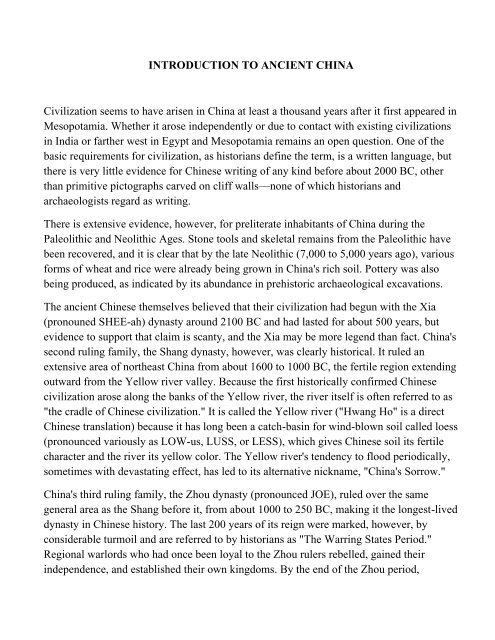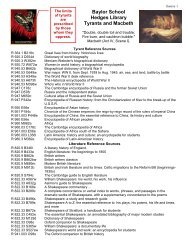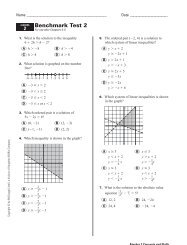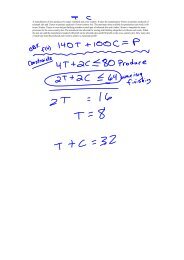INTRODUCTION TO ANCIENT CHINA Civilization seems to have ...
INTRODUCTION TO ANCIENT CHINA Civilization seems to have ...
INTRODUCTION TO ANCIENT CHINA Civilization seems to have ...
Create successful ePaper yourself
Turn your PDF publications into a flip-book with our unique Google optimized e-Paper software.
<strong>INTRODUCTION</strong> <strong>TO</strong> <strong>ANCIENT</strong> <strong>CHINA</strong><br />
<strong>Civilization</strong> <strong>seems</strong> <strong>to</strong> <strong>have</strong> arisen in China at least a thousand years after it first appeared in<br />
Mesopotamia. Whether it arose independently or due <strong>to</strong> contact with existing civilizations<br />
in India or farther west in Egypt and Mesopotamia remains an open question. One of the<br />
basic requirements for civilization, as his<strong>to</strong>rians define the term, is a written language, but<br />
there is very little evidence for Chinese writing of any kind before about 2000 BC, other<br />
than primitive pic<strong>to</strong>graphs carved on cliff walls—none of which his<strong>to</strong>rians and<br />
archaeologists regard as writing.<br />
There is extensive evidence, however, for preliterate inhabitants of China during the<br />
Paleolithic and Neolithic Ages. S<strong>to</strong>ne <strong>to</strong>ols and skeletal remains from the Paleolithic <strong>have</strong><br />
been recovered, and it is clear that by the late Neolithic (7,000 <strong>to</strong> 5,000 years ago), various<br />
forms of wheat and rice were already being grown in China's rich soil. Pottery was also<br />
being produced, as indicated by its abundance in prehis<strong>to</strong>ric archaeological excavations.<br />
The ancient Chinese themselves believed that their civilization had begun with the Xia<br />
(pronouned SHEE-ah) dynasty around 2100 BC and had lasted for about 500 years, but<br />
evidence <strong>to</strong> support that claim is scanty, and the Xia may be more legend than fact. China's<br />
second ruling family, the Shang dynasty, however, was clearly his<strong>to</strong>rical. It ruled an<br />
extensive area of northeast China from about 1600 <strong>to</strong> 1000 BC, the fertile region extending<br />
outward from the Yellow river valley. Because the first his<strong>to</strong>rically confirmed Chinese<br />
civilization arose along the banks of the Yellow river, the river itself is often referred <strong>to</strong> as<br />
"the cradle of Chinese civilization." It is called the Yellow river ("Hwang Ho" is a direct<br />
Chinese translation) because it has long been a catch-basin for wind-blown soil called loess<br />
(pronounced variously as LOW-us, LUSS, or LESS), which gives Chinese soil its fertile<br />
character and the river its yellow color. The Yellow river's tendency <strong>to</strong> flood periodically,<br />
sometimes with devastating effect, has led <strong>to</strong> its alternative nickname, "China's Sorrow."<br />
China's third ruling family, the Zhou dynasty (pronounced JOE), ruled over the same<br />
general area as the Shang before it, from about 1000 <strong>to</strong> 250 BC, making it the longest-lived<br />
dynasty in Chinese his<strong>to</strong>ry. The last 200 years of its reign were marked, however, by<br />
considerable turmoil and are referred <strong>to</strong> by his<strong>to</strong>rians as "The Warring States Period."<br />
Regional warlords who had once been loyal <strong>to</strong> the Zhou rulers rebelled, gained their<br />
independence, and established their own kingdoms. By the end of the Zhou period,
ortheast China was split in<strong>to</strong> seven states or kingdoms which were frequently at war with<br />
one another. It was during these same tumultuous times that Chinese philosophies<br />
developed which were <strong>to</strong> <strong>have</strong> a far-reaching impact. Laozi (or Lao-Tzu) laid the<br />
foundation of Daoism (or Taoism), and Kong Fuzi (or Confucius) sought <strong>to</strong> end the endless<br />
wars between the seven warring Chinese states by educating a new generation of cultured<br />
gentlemen and by urging adoption at the state level of behaviors and principles which had<br />
long made Chinese family life orderly and harmonious.<br />
The fourth Chinese dynasty, the Qin (pronounced CHIN), ruled for the shortest time but<br />
was arguably the most important. The word "China," in fact, is derived from the name of<br />
this ruling family. The Qin state was one of the seven Chinese kingdoms during the<br />
Warring States Period. In the 300's BC, a Qin statesman named Shang Yang introduced a<br />
number of reforms which were <strong>to</strong> <strong>have</strong> significant consequences. First, he introduced a<br />
new political philosophy called "legalism," which mandated the creation of an extensive<br />
and ruthlessly enforced code of laws. The laws were made public so that everyone would<br />
know what they were and the penalties for breaking them. Then the government set out <strong>to</strong><br />
enforce them rigidly and often without mercy. This new policy quickly brought a new level<br />
of order out of what had been at times a political and social situation bordering on chaos.<br />
Second, Shang Yang urged the Qin rulers <strong>to</strong> be secretive and devious in their dealings with<br />
neighboring states. The age-old tradition of war in China as a contest between honorable<br />
gentlemen was set aside, and war became a deadly struggle for advantage on the battlefield.<br />
By remaining secretive about their plans, ambitions, and troop movements, the Qin rulers<br />
and their generals hoped <strong>to</strong> outsmart and if possible trick their enemies. Third, Shang Yang<br />
began appointing governmental officials and military officers on the basis of talent, rather<br />
than on the basis of family or social connections, as had long been the case. Finally,<br />
officials at the Qin court were subjected <strong>to</strong> the constant supervision of their ruler, who<br />
rewarded them handsomely for their achievements and punished them brutally for their<br />
failures. These policies in time made the Qin state the most efficient and ruthless of China's<br />
warring kingdoms.<br />
In 246 BC, Qin Shi Huang became ruler of the Qin state and was <strong>to</strong> become ancient<br />
China's first and most famous emperor. Ironically, he does not seem <strong>to</strong> <strong>have</strong> actually been<br />
the son of the previous Qin ruler. A powerful and influential merchant and statesman at the<br />
Qin court named Lü Buwei (pronounced LOO boo-WAY) allegedly introduced a dancing<br />
girl named Zhao Ji <strong>to</strong> the Qin ruler, and she subsequently bore a son who became Qin Shi<br />
Huang. The Qin king assumed the boy was his son, but it appears that Lü Buwei actually
fathered the child. When the old king died, the boy, whose birth name was Zhao Zheng,<br />
succeeded <strong>to</strong> the throne, although he was only thirteen years old and in need of a mature<br />
advisor, a role which Lü Buwei gladly filled. The young king was carefully instructed in all<br />
the skills a king would need and particularly in the finer points of legalism. In later years,<br />
however, Lü Buwei became fearful that the young king would discover his true origins and<br />
plotted <strong>to</strong> replace him with another son of Zhao Ji. The plot misfired, however, and in 235<br />
BC, when Zhao Zheng was 24 years old, the young king <strong>to</strong>ok firm control of his destiny<br />
and at the same time suppressed the secret of his birth. The step-brother who would <strong>have</strong><br />
replaced him was seized, tied <strong>to</strong> two wagons facing in opposite directions, and literally <strong>to</strong>rn<br />
apart. His mother, Zhao Ji, was confined <strong>to</strong> her rooms in the palace for the rest of her life,<br />
and his father and men<strong>to</strong>r, Lü Buwei, committed suicide.<br />
Five years later, in 230 BC, Zhao Zheng unleashed the Qin army against his neighbors.<br />
The Han state fell <strong>to</strong> his forces that same year, the Zhao state fell in 228 (assisted by a<br />
severe earthquake), followed by the majority of the Yan state in 226, the Wei state in 225,<br />
and in 223 the Chu state, which was the largest of the seven. The last remnants of the Yan<br />
kingdom were conquered in 222 BC, and the last of the Warring States, Qi (pronounced<br />
CHEE), was overrun in 221 BC. Other areas, some as far away as Vietnam, were<br />
conquered by Qin armies after 221 BC. With the fall of China's warring states and their<br />
consolidation under Qin control, Zhao Zheng could legitimately claim <strong>to</strong> be China's first<br />
emperor, whose authority extended over a vast region within northeast China. He was<br />
afterward called Qin Shi Huang, meaning "First Qin Emperor."<br />
Another achievement for which Qin Shi Huang is famous was the original construction of<br />
China's Great Wall, built <strong>to</strong> keep northern nomadic warriors out of his domain. The present<br />
Great Wall was not built until much later, but it follows the general path of the earlier and<br />
less robust wall constructed in the 220's BC.<br />
During his reign, Qin Shi Huang survived at least two assassination attempts and in his<br />
later years became obsessed with finding the secret <strong>to</strong> eternal youth and life. He sent agents<br />
across China in search of this magical substance and <strong>to</strong>ok many experimental potions <strong>to</strong><br />
fortify his health. Ironically, his death in 210 BC may <strong>have</strong> been due <strong>to</strong> a potion containing<br />
mercury, now known <strong>to</strong> be a deadly poison. He was succeeded by one of his sons, who was<br />
in no way the equal of his father, and the Qin dynasty collapsed in 207 BC.
Qin Shi Huang was also obsessed in his later years with his eventual burial arrangements.<br />
For years, rumors abounded about his rich burial site, but it evaded discovery until 1974,<br />
when the <strong>to</strong>mb site was accidentally stumbled upon by some Chinese farmers. Ancient<br />
sources recorded that work began on the site when Zhao Zheng was thirteen years old and<br />
that it continued through most of his life. Over 700,000 laborers worked on the site. The<br />
emperor's kingdom was laid out in miniature detail within the <strong>to</strong>mb and supposedly<br />
featured rivers of flowing mercury. Artisans created thousands of life-size soldiers, each<br />
with unique physical characteristics and representing the diverse ethnic mix within the<br />
emperor's army. They were arrayed in rows and ranks, as on the battlefield in life, and then<br />
buried, <strong>to</strong> stand guard for eternity over the royal <strong>to</strong>mb. Each figure is made of terra cotta,<br />
the same material from which pots are made. To date, over 8000 soldiers, 100 chariots, and<br />
500 horses <strong>have</strong> been discovered, most of them still awaiting conservation by<br />
archaeologists. The probable site of the emperor's <strong>to</strong>mb itself has been identified, but since<br />
it resides beneath a literal mountain of earth, its excavation will be slow and difficult, and<br />
will probably require the efforts of generations of archaeologists. The <strong>to</strong>mb of Qin Shi<br />
Huang was thus as monumental as his career.<br />
China's second empire was controlled by the Han dynasty (pronounced HAHN), which<br />
ruled an area even more extensive than that of the Qin dynasty before it. Han emperors<br />
ruled China for more than 400 years, from 206 BC <strong>to</strong> 220 AD, a period which is<br />
considered ancient China's golden age. Even <strong>to</strong>day, the people of China generally refer <strong>to</strong><br />
themselves as "the Han."<br />
During the reign of the Han, Han armies were regularly employed in putting down<br />
rebellions and in taming the barbarian nomads on China's northern border. Parts of central<br />
and southern China were incorporated in<strong>to</strong> the Chinese empire for the first time, including<br />
the rich Yangtze river valley. Buddhism first entered China from India during the reign of<br />
the Han, but the state officially sanctioned Confucianism, and education was focused on<br />
detailed knowledge of classic Confucian literature. A new law code was introduced, some<br />
of which was new and some of which was drawn from the laws of the previous Qin empire.<br />
Coins were put in<strong>to</strong> circulation, trade expanded, and the Han state grew rich and<br />
prosperous. In addition, improvements were made in metal technology, and the first<br />
manufacturing process for paper was invented. Advances in astronomy, medicine, and<br />
mathematics were also made. In short, the Han dynasty witnessed a range of important<br />
achievements for which ancient China is justifiably remembered and respected.









